Search
To search for an exact match, type the word or phrase you want in quotation marks.
A*DESK has been offering since 2002 contents about criticism and contemporary art. A*DESK has become consolidated thanks to all those who have believed in the project, all those who have followed us, debating, participating and collaborating. Many people have collaborated with A*DESK, and continue to do so. Their efforts, knowledge and belief in the project are what make it grow internationally. At A*DESK we have also generated work for over one hundred professionals in culture, from small collaborations with reviews and classes, to more prolonged and intense collaborations.
At A*DESK we believe in the need for free and universal access to culture and knowledge. We want to carry on being independent, remaining open to more ideas and opinions. If you believe in A*DESK, we need your backing to be able to continue. You can now participate in the project by supporting it. You can choose how much you want to contribute to the project.
You can decide how much you want to bring to the project.
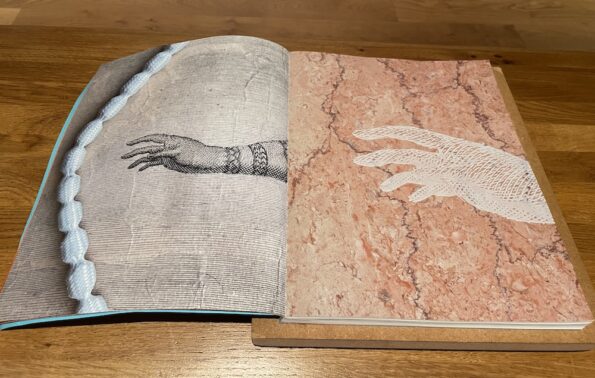
Pio Abad has been nominated for the 2024 Turner Prize for his Ashmolean NOW exhibit To Those Sitting in Darkness. Here are some compelling reasons why.
I first saw Pio Abad’s (b. 1983) work six months ago at the Taipei Biennale, where his commissioned installation, Laji No. 97, featured prominently. In an immense room, the artist formed lines of poetry from rich, dark earth on a pristine white and gray marble floor, creating the physical manifestation of a song that has survived largely through oral tradition.
For Laji No. 97, Abad travelled from the windswept island of Batanes in the northernmost part of the Philippine archipelago, to Lanyu, the southernmost island of Taiwan. The installation celebrates the unexpected similarities the artist found between the Ivatan of Batanes and the Tao people of Lanyu, shifting our attention away from the often arbitrary nature of national borders, towards the very real, yet unnamed webs of culture created by transoceanic migration.
Booklets of poetry with artist illustrations were offered to museum-goers, and if you were to read a poem, then look at the installation, you could almost feel the immensity of the ocean, which might, at any moment, sweep away the earthen text forever.
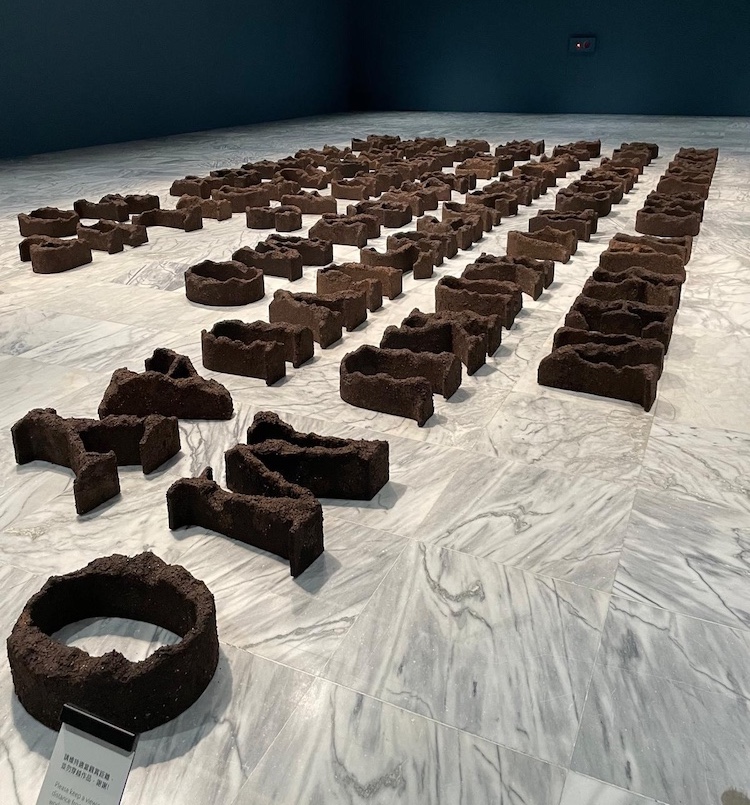
“Laji No. 97.” Photo: M.V. Yujuico
***
Pio Abad’s work, which embraces drawing, painting, textiles, text and installations, is meticulously researched and has the ability to draw out and illuminate connections between seemingly disparate people, objects and ideologies. He does so in a lyrical way, eliciting curiosity through the seduction inherent in precisely rendered objects. I have read countless books which do the same with words, but had never encountered this done so effectively in the visual arts. You can best observe the artist’s work at the Ashmolean Museum at Oxford.
***
Just a little over an hour’s train ride out of central London will take you to the picturesque town of Oxford. And from there, it is a short, pleasant walk to the Ashmolean. Like many British national museums, flags outside announce it is free to enter. To those Sitting in Darkness, (until September 8, 2024) is the second iteration of the Ashmolean NOW series. Launched in 2023 and curated by Lena Fritsch, Ashmolean NOW invites contemporary artists to engage with works from its vast historic collection and create new responses to them.
For his work here, Abad has been nominated for Britain’s most prestigious contemporary art award, the Turner Prize. He is one of four nominees whose work will be exhibited at Tate Britain from September 2024 to February 2025. A winner is announced in December. The title To Those Sitting in Darkness is based on a satirical anti-imperialist document written by American author Mark Twain, “To the Person sitting in darkness” (1901). Abad’s exhibition titles are frequently grounded in literary reference, so it’s no surprise to find it here. The exhibit is not specifically about the Philippines, but its focus on bringing to light repressed narratives within the context of colonialism and cultural loss inevitably make it so.
The show is prominently located within the Ashmolean, occupying prime real estate between café and gift shop, reflecting the democratic priorities of current museography. The exhibition, which can be better described as a transdisciplinary polyphonic narrative, is housed in a long rectangular room painted a deep, turquoise-tinted black. Each work is illuminated deftly, so as a viewer, you feel as though it is, in fact, you in the darkness, on a journey of discovery as you approach each object on display.
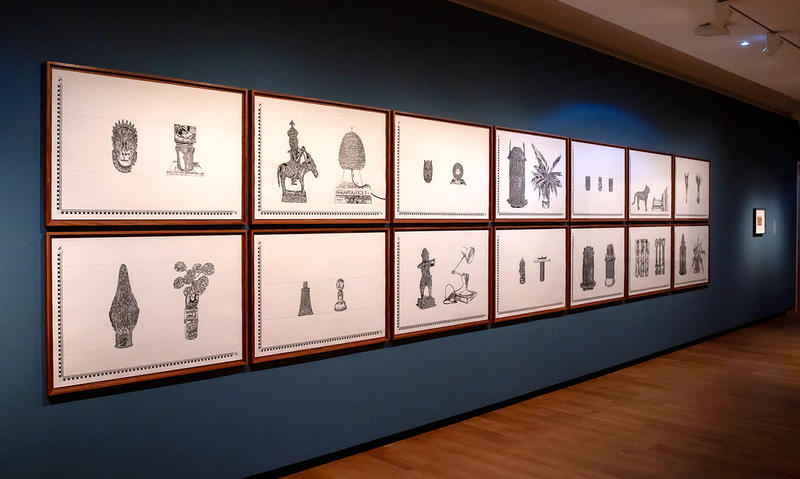
Exhibition view, drawings by Pio Abad. Courtesy of Ashmolean museum © Ashmolean Museum / Hannah Pye
The range of this exhibit is mind-boggling. It crisscrosses the globe, from Asia to the Americas through Europe and Africa, as it explores transnational webs involving the trafficking of human bodies, cycles of plunder and impunity, and the hegemonic taxonomies of today which relegate historical memory to oblivion. And yet the exhibit doesn’t lose focus because one senses the artist wholly embedded in each narrative.
Before going around the room, it is worth taking note of a self-portrait by curator and visual artist, Filipino-American Carlos Villa (1936-2013), displayed directly across from the exhibit entrance. In Tat2 (1971) Villa superimposed a tattoo on his face. Although the Philippine’s rich tattooing history is now commonly known, for this, Villa used motifs taken from Oceanic cultures because of the lacuna that existed in Philippine art historiography at the time. This syncretic way of art-making has influenced Abad and Carlos Villa’s presence is meaningful here.

Carlos Villa, “Tat2,” 1971. Courtesy of Ashmolean museum © Carlos Villa State
Picking up on the tattoo theme, you will come to an old book in a plexiglass case as you make your way clockwise around the room. An open page displays an engraving of an elaborately tattooed young man in contrapposto, right hand gracefully reaching out.
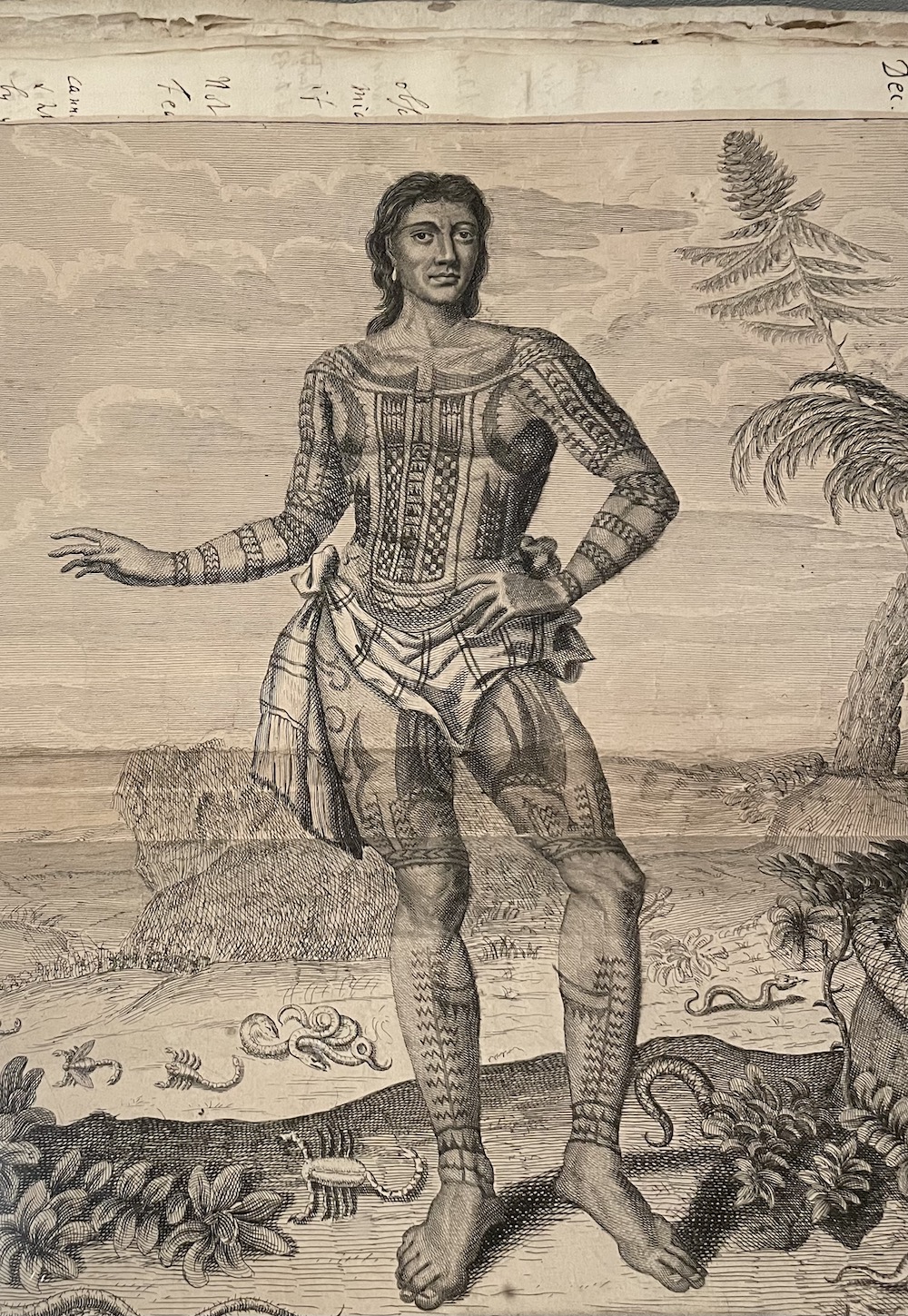
John Savage, “Portrait of Prince Giolo, Son of King Moangis,” 1692. Photo: M.V. Yujuico
In Giolo’s Lament, Abad recovers the story of a boy kidnapped with his mother by failed British privateer William Dampier. Enslaved, the boy known as Prince Giolo is taken to England against his will, then sold repeatedly, his elaborately tattooed body exhibited as a curiosity. Eleven engravings on flesh-colored marble are arranged along the wall like a musical score, portraying Prince Giolo’s hand, white and ghost-like. He reaches out, perhaps to his dying mother, or perhaps to us, before disappearing in an almost cinematic retelling in stone.

Exhibition view of Pio Abad, “Giolo’s Lament,” 2023. Photo: M.V. Yujuico
At the far short wall of the rectangular room are fabrics woven in the aftermath of the carpet-bombing of the southern city of Marawi in 2017 by the Philippine national government. The fabrics serve as backdrops for 19th century Moro swords taken from the defeated warriors. The national government today dehumanizes portrayals of the Moro, a colonial habit inherited from former colonizer Spain. Displaying Moro weaving and weaponry as Filipino national artifacts can be an act of violence, challenging prevailing taxonomies of the Philippines as a Christian country.

Decorated knife, sheath and belt made in Philippines, 19th century shown on Sinagtala woven fabric, 2017 © Pitt Rivers Museum
We end with two tiaras in the center of the room, rendered in bronze by Abad’s partner, jeweler Frances Wadsworth Jones. Replicas of the Kokoshnik tiara, owned first by the Romanov family, the Bolsheviks, then Stalin, English royalty, and then purchased by kleptocrat Imelda Marcos in from Christie’s 1978, they are symbols of cyclical upheaval, violence and impunity.
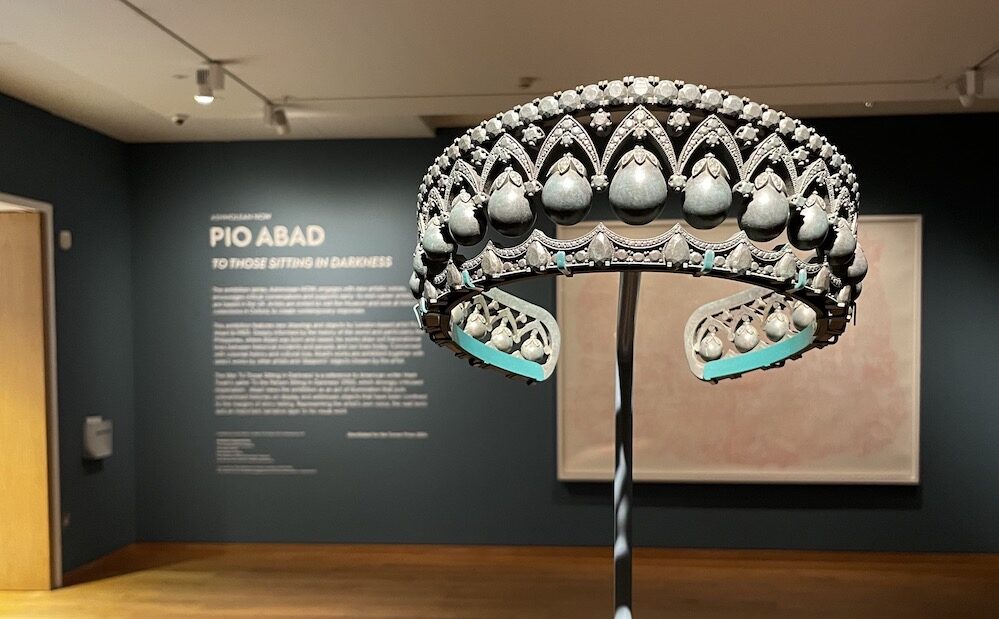
Pio Abad and Frances Wadsworth Jones, “For the Sphinx,” 2023. Photo: M.V. Yujuico
(Cover photo: Image from exhibition catalogue work of Pio Abad, “Giolo’s Lament”, 2023. Photo: M.V. Yujuico)
All info at the Ashmolean museum web site.
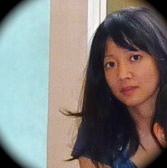
Maria Victoria Yujuico lives somewhere at the intersection of art, literature and modern life. She holds a masters in Spanish and Latin American literature and is a student of contemporary art at IL3-Universidad de Barcelona. Home is between Monterey Bay and the San Francisco Bay Area in California.
"A desk is a dangerous place from which to watch the world" (John Le Carré)